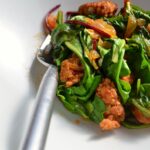Embark on a culinary journey to the sun-drenched isles of Greece, reimagined through the lens of the Paleo diet. This collection of recipes seamlessly blends the vibrant flavors of traditional Greek cuisine with the health-conscious principles of Paleo eating. Imagine succulent grilled lamb infused with fragrant herbs, alongside crisp salads bursting with fresh vegetables and a drizzle of olive oil. Prepare to tantalize your taste buds and nourish your body with dishes that are both delicious and deeply satisfying, all while adhering to the Paleo lifestyle.
We’ll explore authentic Greek ingredients, their nutritional powerhouses, and how to source the best quality. Learn to adapt beloved traditional recipes, mastering substitutions that preserve both flavor and Paleo compliance. Discover three unique Paleo dinner recipes featuring chicken, lamb, and seafood, each meticulously detailed with step-by-step instructions and captivating descriptions of their textures, aromas, and visual appeal. We’ll even guide you through creating a complete three-course Paleo Greek feast, from appetizer to dessert, ensuring an unforgettable dining experience.
Authentic Greek Paleo Ingredients

The vibrant flavors of traditional Greek cuisine lend themselves beautifully to a Paleo lifestyle. By focusing on fresh, whole foods, we can recreate the essence of Greek cooking while adhering to Paleo principles. This involves understanding the nutritional power of authentic ingredients and making informed substitutions when necessary. The following exploration delves into the heart of authentic Greek Paleo ingredients, highlighting their benefits and providing context for creating delicious and healthy meals.
Authentic Greek Ingredients and their Nutritional Benefits
The cornerstone of any authentic Greek Paleo meal lies in its ingredients. These ingredients, often sourced from the sun-drenched lands of Greece, boast a rich nutritional profile that contributes to overall health and well-being. The following table showcases some key examples, emphasizing their nutritional value and offering Paleo substitutions where needed.
| Ingredient | Nutritional Benefit | Paleo Substitute (if applicable) | Traditional Greek Dish Example |
|---|---|---|---|
| Olive Oil | Rich in monounsaturated fats, antioxidants (vitamin E), and anti-inflammatory compounds. Supports heart health and reduces the risk of chronic diseases. | Avocado oil (similar flavor profile, though slightly different fatty acid composition) | Greek Salad, Spanakopita (using olive oil in the pastry) |
| Lamb | Excellent source of protein, iron, and B vitamins. Provides essential amino acids crucial for muscle building and repair. | N/A | Souvlaki, Kleftiko |
| Salmon (wild-caught) | High in omega-3 fatty acids, protein, and vitamin D. Supports brain health, reduces inflammation, and strengthens the immune system. | Other fatty fish like mackerel or sardines | Grilled Salmon with lemon and herbs |
| Leafy Greens (e.g., Kale, Spinach, Chard) | Excellent source of vitamins A, C, and K, as well as minerals like iron and calcium. Supports healthy digestion and boosts the immune system. | Other dark leafy greens | Horta (boiled greens), Spanakopita |
| Tomatoes | Rich in lycopene, a powerful antioxidant linked to reduced cancer risk. Also a good source of vitamin C and potassium. | N/A | Greek Salad, Avgolemono |
| Cucumbers | High in water content, providing hydration and supporting healthy digestion. Also a source of vitamin K and antioxidants. | N/A | Greek Salad |
| Onions & Garlic | Contain allicin, a compound with potent antimicrobial and anti-inflammatory properties. Contribute to overall health and immunity. | N/A | Various dishes as flavor enhancers |
| Olives (Kalamata, etc.) | Good source of healthy fats, fiber, and antioxidants. Supports heart health and provides satiety. | N/A | Greek Salad, various appetizers |
| Feta Cheese (Goat or Sheep’s Milk – Check for Paleo-friendly versions, often made without added sugars or starches) | Source of protein, calcium, and probiotics (depending on production method). Note: Traditional feta often contains added sugars or starches, so carefully check labels. | Homemade Paleo feta cheese (using goat or sheep’s milk) | Greek Salad, Spanakopita (use sparingly) |
Sourcing High-Quality, Ethically Produced Greek Ingredients
Securing high-quality, ethically produced Greek ingredients is key to creating authentic and nutritious Paleo meals. Look for suppliers committed to sustainable farming practices, animal welfare, and minimal processing. Farmers’ markets, specialty food stores, and online retailers specializing in Greek products are excellent resources. Consider purchasing ingredients directly from Greek producers when possible, supporting local economies and ensuring freshness. The visual of vibrant, sun-ripened tomatoes, plump olives glistening with olive oil, and herbs bursting with fragrance, all sourced ethically, elevates the entire culinary experience.
Traditional Greek Ingredients vs. Modern Paleo Counterparts
While many traditional Greek ingredients seamlessly integrate into a Paleo diet, some require mindful consideration. For instance, some traditional Greek breads and pastries incorporate grains and sugars, which are not Paleo-compliant. Similarly, certain cheeses may contain added starches or sugars. By understanding these differences, one can make informed substitutions. For example, substituting almond flour for wheat flour in recipes or opting for a Paleo-friendly feta alternative ensures adherence to Paleo principles without sacrificing the essence of Greek flavors. The key is to prioritize whole, unprocessed foods and make conscious choices that reflect both the traditional spirit of Greek cooking and the tenets of the Paleo diet.
Step-by-Step Guide to a Complete Greek Paleo Dinner
This guide details the preparation of a delicious and authentic three-course Greek-inspired Paleo dinner, highlighting the simplicity and vibrant flavors of Mediterranean cuisine. Each course is designed to be both satisfying and visually appealing, showcasing the natural beauty of the ingredients.
Preparing the Main Course: Lemon Herb Roasted Chicken with Potatoes
This vibrant main course combines tender, succulent chicken with the earthy sweetness of roasted potatoes, all infused with the bright, zesty flavor of lemon and fresh herbs. The roasting process allows the flavors to meld beautifully, creating a dish that is both comforting and sophisticated.
- Preheat your oven to 400°F (200°C). This ensures the chicken cooks evenly and the potatoes achieve a satisfyingly crispy exterior.
- Prepare the chicken: Rinse a whole, approximately 3-pound chicken and pat it dry. Season generously with salt, freshly ground black pepper, dried oregano, and thyme. Place lemon slices inside the cavity of the chicken for added flavor and moisture.
- Prepare the potatoes: Peel and cube approximately 2 pounds of Yukon Gold potatoes. Toss them in olive oil, salt, pepper, and a sprinkle of dried rosemary.
- Assemble and roast: Place the chicken in a roasting pan and surround it with the seasoned potatoes. Roast for approximately 1 hour and 15 minutes, or until the chicken is cooked through (internal temperature reaches 165°F/74°C) and the potatoes are tender and golden brown. Basting the chicken with pan juices halfway through the cooking process will enhance its juiciness.
- Rest and serve: Once cooked, remove the chicken from the oven and let it rest for 10-15 minutes before carving. This allows the juices to redistribute, resulting in a more tender and flavorful chicken. Serve the chicken alongside the roasted potatoes.
Creating the Side Dish: Greek Salad with Kalamata Olives
A classic Greek salad is the perfect accompaniment to the roasted chicken. The vibrant colors and fresh flavors of the vegetables provide a delightful contrast to the richness of the main course. This salad is simple to prepare, yet bursting with Mediterranean sunshine.
- Prepare the vegetables: Wash and chop 1 cucumber, 1 pint of cherry tomatoes, and 1 red onion. The size of the cuts can be adjusted to your preference.
- Combine ingredients: In a large bowl, combine the chopped cucumber, tomatoes, and red onion. Add 1/2 cup of Kalamata olives, a generous handful of crumbled feta cheese (optional, for those not strictly following a Paleo diet, consider a Paleo-friendly cheese alternative), and fresh oregano leaves.
- Dress the salad: Drizzle the salad with a generous amount of high-quality extra virgin olive oil and a squeeze of fresh lemon juice. Season with salt and pepper to taste. Gently toss to combine all the ingredients.
- Serve immediately: The Greek salad is best served fresh, allowing the flavors of the vegetables and herbs to shine through. The vibrant colors of the ingredients create a visually stunning side dish.
Preparing the Dessert: Baked Apples with Cinnamon and Honey
This simple yet elegant dessert offers a sweet and comforting end to the meal. The baked apples are infused with the warm spice of cinnamon and the natural sweetness of honey, providing a satisfyingly healthy treat.
- Preheat oven to 350°F (175°C). This gentle heat ensures the apples bake evenly without becoming mushy.
- Prepare the apples: Core 2 medium-sized apples (such as Honeycrisp or Fuji) leaving the bottom intact. Avoid completely removing the core, as it helps the apples maintain their shape.
- Stuff the apples: Fill the cored apples with a mixture of 1 tablespoon of honey, 1/2 teaspoon of cinnamon, and a sprinkle of nutmeg.
- Bake the apples: Place the stuffed apples in a baking dish and add a small amount of water to the bottom of the dish to prevent sticking. Bake for approximately 30-40 minutes, or until the apples are tender and the filling is bubbly.
- Serve warm: Serve the baked apples warm, perhaps with a dollop of unsweetened Greek yogurt (optional, for those not strictly adhering to a Paleo diet). The warm, spiced apples offer a delightful contrast to the savory courses preceding them.
This exploration of Greek-inspired Paleo recipes has unveiled a world of culinary possibilities, proving that healthy eating doesn’t mean sacrificing flavor or tradition. By understanding the nutritional benefits of authentic Greek ingredients and mastering the art of Paleo adaptation, you can create stunning, flavorful meals that nourish your body and delight your senses. So, gather your ingredients, embrace the vibrant flavors of Greece, and embark on your own Paleo culinary adventure. The possibilities are as endless as the Aegean Sea itself.
Query Resolution
What are some common Paleo substitutes for traditional Greek ingredients?
Common substitutions include using olive oil instead of butter, almond flour for wheat flour, and using coconut aminos or apple cider vinegar instead of soy sauce or regular vinegar.
Can I make these recipes ahead of time?
Many components, such as marinades and side dishes, can be prepared a day or two in advance, simplifying your dinner preparation.
Are these recipes suitable for beginners?
Yes, the recipes are designed with clear, step-by-step instructions, making them accessible to cooks of all skill levels.
Where can I find high-quality Paleo-friendly Greek ingredients?
Look for local farmers’ markets, specialty food stores, and online retailers specializing in organic and ethically sourced products.


